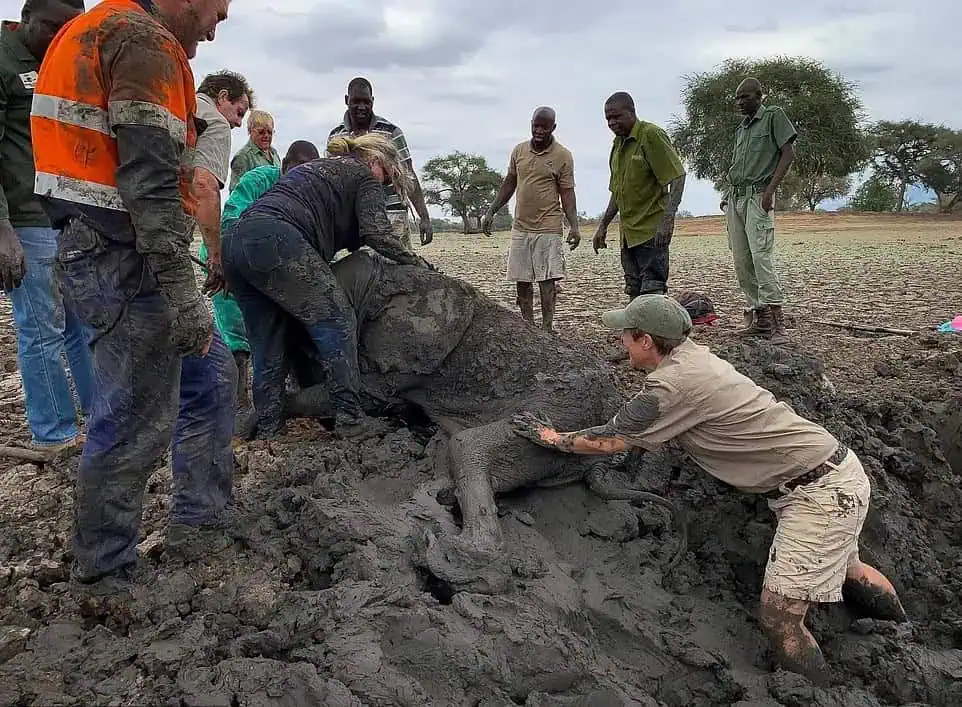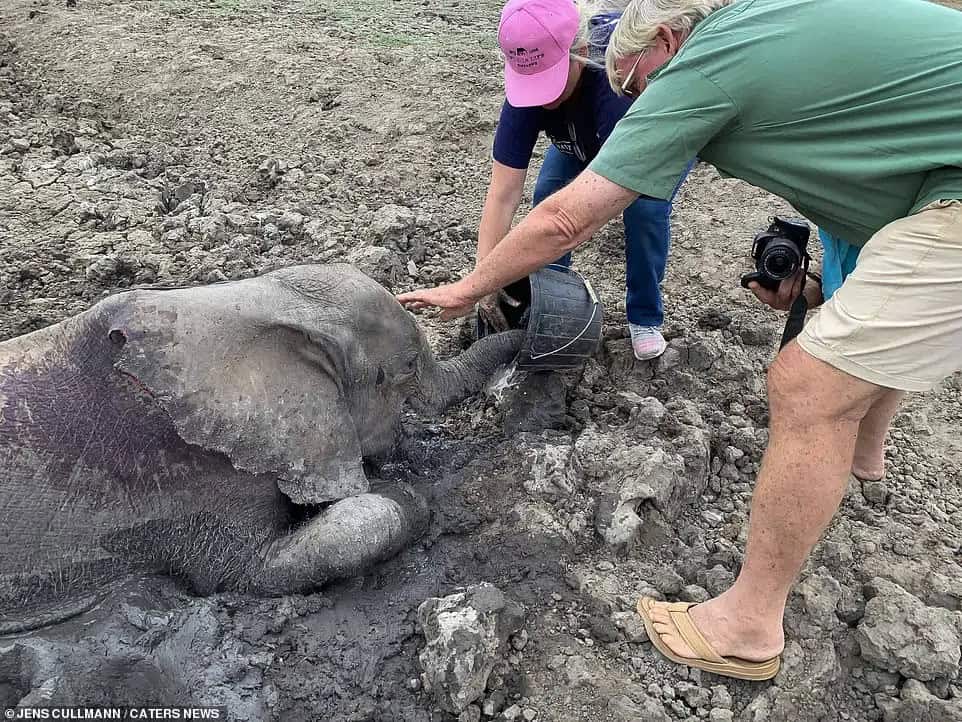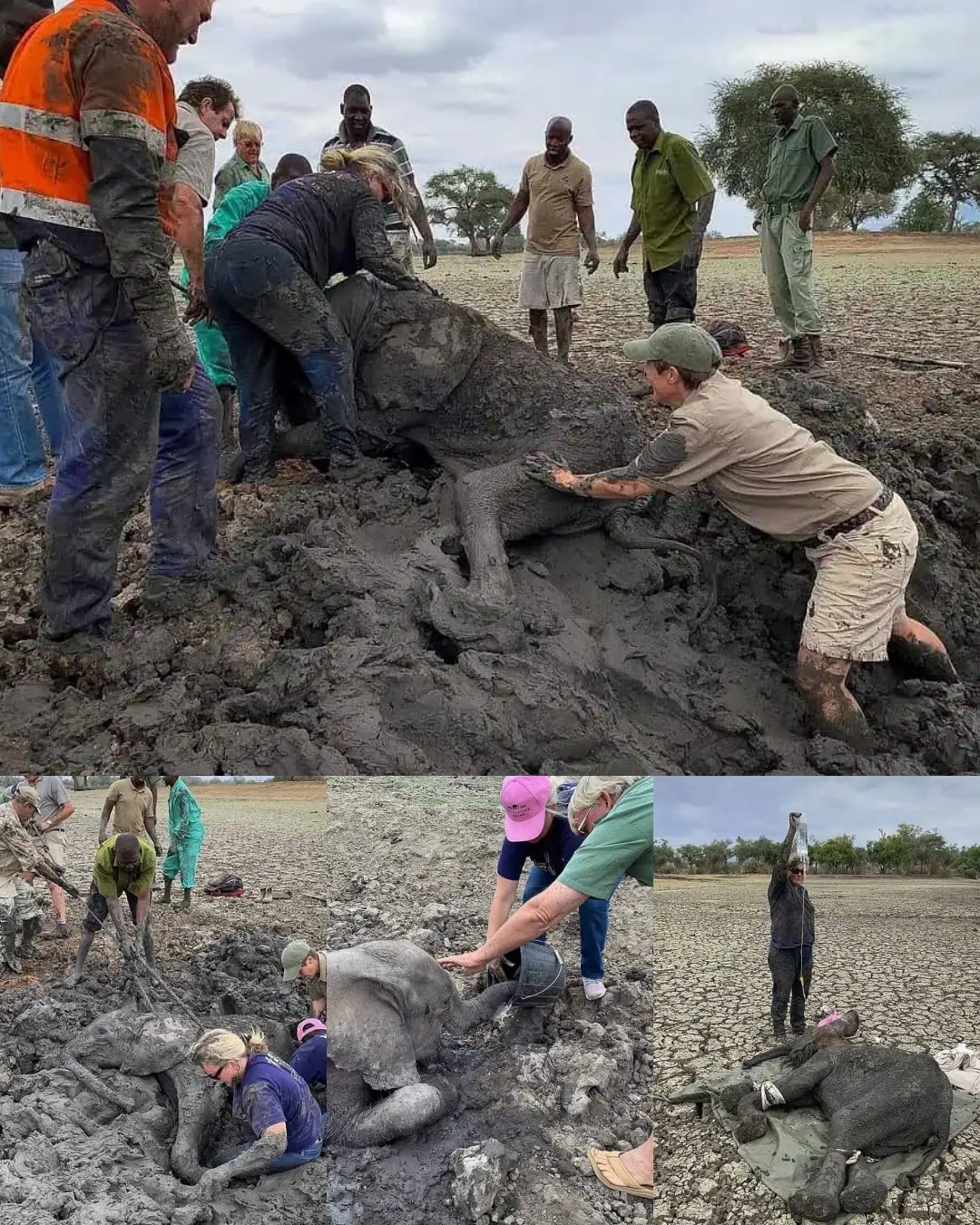When the Earth Tested Compassion
On a sun-baked afternoon in Zimbabwe’s Mana Pools National Park, the air shimmered with heat and the ground cracked underfoot. The drought that year had been particularly severe, drying rivers and shrinking waterholes to shallow puddles of mud. In this challenging landscape, two baby elephants—later named Tess and Mana—found themselves trapped in a muddy depression, struggling to escape.
Their cries echoed across the savannah until fate intervened in the form of a passing wildlife photographer, Jens Cullmann, whose quick action would spark one of the most inspiring rescue stories in modern wildlife conservation. What followed was a moving journey of survival, compassion, and the extraordinary bond between humans and animals.

The Discovery – A Moment That Changed Everything
While exploring Mana Pools National Park, Jens Cullmann noticed unusual movement near a drying waterhole. As he approached, he realized that two young elephants were stuck deep in mud, unable to move. The scene was heartbreaking: the animals were exhausted, their efforts to free themselves only causing them to sink deeper.
Cullmann immediately contacted ‘Wild is Life,’ a wildlife sanctuary in Zimbabwe known for its expertise in animal rescue and rehabilitation. Within hours, a team of volunteers, including veterinarians and conservation specialists, was mobilized. The race against time had begun—not just to save the elephants, but to uphold the very spirit of coexistence between humans and nature.

The Rescue Mission – Teamwork in Action
The rescue team arrived equipped with ropes, shovels, and immense determination. The mud was thick and unyielding, and the afternoon sun made every movement a challenge. Working in shifts, volunteers dug around the elephants to reduce the suction effect that kept them trapped.
After hours of coordinated effort, the team finally succeeded in pulling Tess and Mana to solid ground. Cheers erupted across the plain—a shared moment of relief and triumph. But the work was far from over. The young elephants were exhausted and weak, requiring immediate medical attention.
Veterinarians administered fluids to help them recover from dehydration and monitored their vital signs. Once stabilized, the next phase of their journey began—a flight to safety and healing at the Zimbabwe Elephant Nursery, part of the Wild is Life Trust.
The Road to Recovery – Healing with Heart
At the nursery, Tess and Mana were given the care they desperately needed. The facility, designed specifically for orphaned or injured elephants, offered not just medical support but also emotional rehabilitation. Caregivers provided milk formula, soft vegetation, and gentle companionship to help the calves rebuild trust.
Wildlife specialists explain that elephants are highly social and emotionally intelligent creatures. When separated from their herd, they can experience stress similar to grief. For this reason, Tess and Mana were introduced gradually to other young elephants at the sanctuary, forming new bonds that would help them regain confidence.
Over time, both elephants began to thrive. Their playful interactions, curious exploration, and growing strength symbolized the power of compassion and human dedication in restoring balance to nature.
The Cultural Symbolism of Elephants
Across Africa and Asia, elephants are more than majestic animals—they are revered symbols of wisdom, loyalty, and strength. In Zimbabwean culture, elephants represent community and endurance. Many local traditions view them as guardians of the forest and protectors of harmony between humans and nature.
The rescue of Tess and Mana thus carried deep cultural resonance. It reminded people of the importance of respecting wildlife not as distant creatures, but as integral members of the planet’s shared ecosystem.
In global culture, too, elephants hold a place of honor. From ancient mythology to modern conservation campaigns, they embody qualities humanity aspires to—gentleness, memory, and unity. The story of Tess and Mana became a metaphor for hope, demonstrating that when compassion leads, miracles can follow.

The Science Behind Elephant Resilience
From a scientific perspective, elephants are among the most remarkable mammals on Earth. Research published in Nature Communications and Scientific American highlights their exceptional intelligence, memory, and social complexity. They can recognize dozens of individuals by sound and scent, navigate vast landscapes using environmental cues, and communicate using infrasonic frequencies that travel for miles.
The recovery of Tess and Mana also sheds light on how young elephants adapt after trauma. According to studies from the David Sheldrick Wildlife Trust and World Wildlife Fund (WWF), orphaned elephants can successfully reintegrate into the wild when given proper emotional and social support. Caregivers often act as surrogate family members, providing stability until the elephants are ready to join larger herds.
Scientifically, such rehabilitation underscores the interconnectedness of biology and empathy. Emotional well-being directly influences physical recovery in social animals like elephants, mirroring how human care and compassion can trigger healing responses even at the cellular level.
Conservation Lessons – Humanity’s Shared Responsibility
Tess and Mana’s survival was more than a rescue; it was a call to action. Across Africa, elephant populations continue to face challenges due to habitat loss and environmental stress. Climate change has intensified droughts, altering migration patterns and reducing access to water and vegetation.
Organizations such as Wild is Life, Save the Elephants, and African Wildlife Foundation are working tirelessly to address these challenges through education, anti-poaching initiatives, and habitat restoration. Public awareness stories like Tess and Mana’s play a vital role in inspiring global empathy and support.
By highlighting successful rescues, conservationists aim to show that positive change is possible. Every act of kindness—donating to sanctuaries, supporting eco-tourism, or spreading awareness—helps preserve ecosystems and protect wildlife for future generations.
The Role of Human Empathy in Conservation
At the heart of this story lies one universal truth: compassion is a force of nature. The emotional connection between people and animals can transcend boundaries and inspire collective action.
Studies in environmental psychology suggest that empathy toward animals strengthens pro-conservation behavior. When individuals witness stories of rescue and recovery, they are more likely to engage in environmentally responsible actions, such as reducing waste or supporting sustainable products.
In the case of Tess and Mana, the compassion of one person—Jens Cullmann—set in motion a chain of events that saved two lives and inspired thousands worldwide. His actions illustrate how empathy can transform into measurable change when combined with organization and purpose.

Myth and Science – A Bridge Between Worlds
Throughout history, elephants have inspired both myth and science. In ancient African folklore, elephants were believed to carry the wisdom of ancestors, guiding humans toward balance with nature. In Hindu and Buddhist traditions, the elephant-headed deity Ganesha symbolizes prosperity, intelligence, and the removal of obstacles.
Modern science, while rooted in empirical evidence, echoes many of these symbolic insights. Researchers have confirmed that elephants demonstrate problem-solving skills, emotional intelligence, and even mourning behavior—traits once described in spiritual or mythic language.
By exploring both perspectives, we see that myth and science do not compete; they complement one another. Myth gives emotional meaning to natural phenomena, while science provides the factual foundation. Together, they deepen our appreciation of life’s interconnectedness.
A Story That Inspires the World
News of Tess and Mana’s rescue spread far beyond Zimbabwe. Wildlife enthusiasts, educators, and environmentalists shared their story across social media, celebrating not just the rescue itself but the message it carried: that empathy and cooperation can overcome even nature’s toughest challenges.
The elephants’ recovery became a case study in hope—a demonstration that small acts of kindness can ripple outward to create global awareness. Schools used the story to teach about conservation ethics, while travel organizations promoted responsible eco-tourism that supports sanctuaries like Wild is Life.
The rescue also inspired discussions about the importance of storytelling in conservation. Experts note that emotional narratives have a unique power to engage audiences and mobilize support. When people connect emotionally with animals like Tess and Mana, they become more invested in protecting them.

Reflection – What Tess and Mana Teach Us About Humanity
Tess and Mana’s journey reminds us that compassion, science, and culture are all threads in the same fabric of life. Their survival was not just a victory for wildlife—it was a reflection of the best qualities of humankind: empathy, courage, and cooperation.
In a world often divided by difference, stories like this bridge the gap between people and nature. They remind us that our well-being is tied to the health of the ecosystems we share. Protecting animals is not merely an act of charity; it is an investment in the planet’s future.
As Tess and Mana continue their journey toward eventual release into the wild, their story stands as a gentle but powerful lesson. Hope is not passive—it is built through action, compassion, and an understanding that every life, no matter how small, has value.
In the end, human curiosity and empathy are what drive progress. The same curiosity that leads scientists to study elephant communication is the same force that moves rescuers to act when they hear a cry for help. Together, these impulses define what it means to be truly human.
Sources
-
Wild is Life Trust – https://www.wildislife.org
-
World Wildlife Fund (WWF) – https://www.worldwildlife.org
-
Save the Elephants – https://www.savetheelephants.org
-
African Wildlife Foundation – https://www.awf.org
-
David Sheldrick Wildlife Trust – https://www.sheldrickwildlifetrust.org
-
National Geographic: The Emotional Lives of Elephants
-
Nature Communications: Elephant Social Intelligence and Environmental Adaptation
-
uStories by Feji.io
